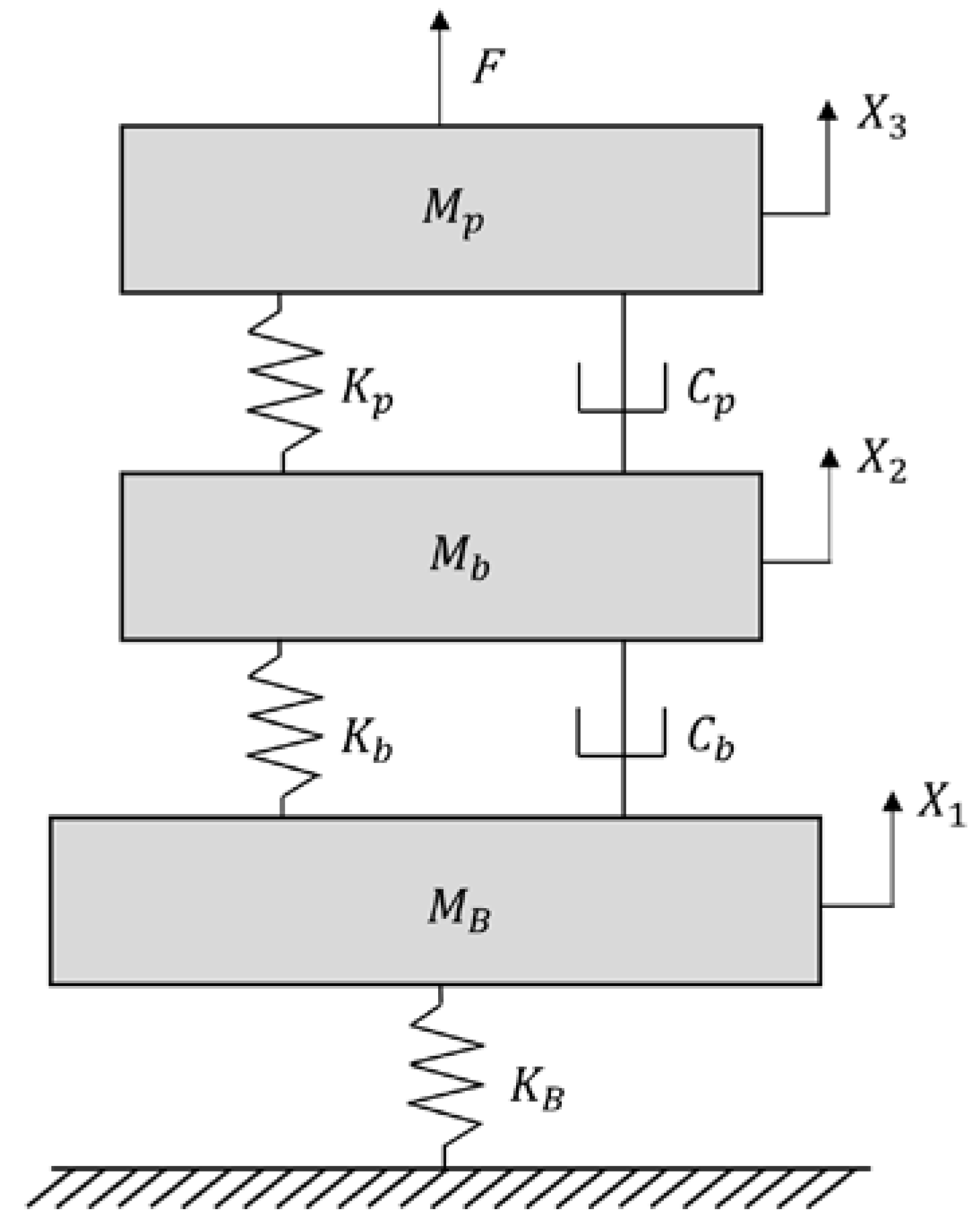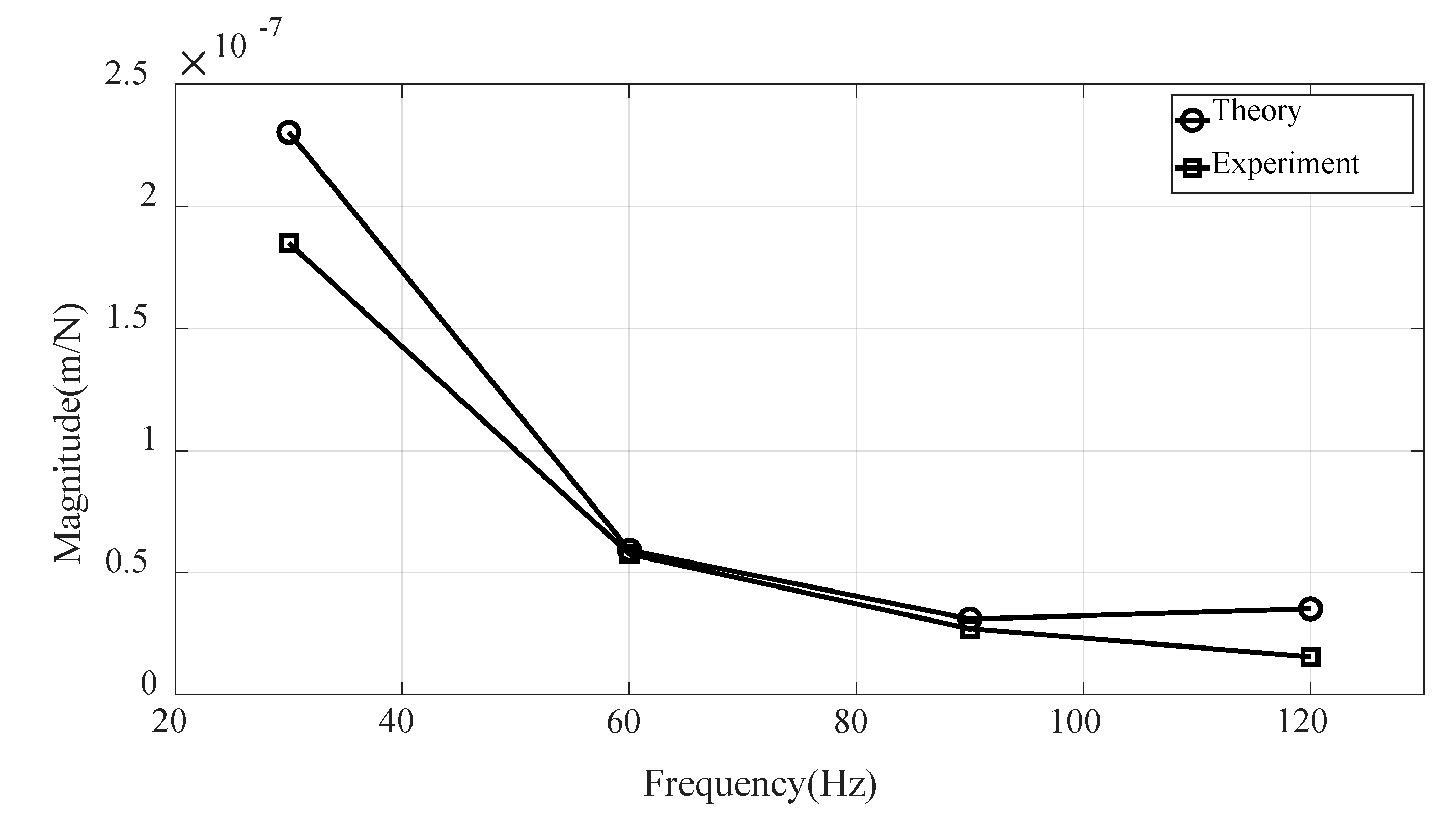Design Criterion of Damper Component of Passive-Type Mount Module without Using Base Mass-Block
Abstract
:1. Introduction
2. System Modeling of Electric Power Plant
2.1. Electric Power Plant with Current Passive Mount Module
2.2. Electric Power Plant with Proposed Passive Mount Module
3. Design Criterion of Damper Component
4. Experimental Validation
5. Conclusions
Acknowledgments
Conflicts of Interest
References
- Gu, X.; Yu, Y.; Li, J.; Li, Y. Semi-active control of magnetorheological elastomer base isolation system utilizing learning-based inverse model. J. Sound Vib. 2017, 406, 346–362. [Google Scholar] [CrossRef]
- Santos, M.B.; Coelho, H.T.; Neto, F.P.L.; Mafhoud, J. Assessment of semi-active friction dampers. Mech. Syst. Signal Process. 2017, 94, 33–56. [Google Scholar] [CrossRef]
- Oh, H.U.; Choi, Y.J. Enhancement of pointing performance by semi-active variable damping isolator with strategies for attenuating chattering effects. Sens. Actuators A 2011, 165, 385–391. [Google Scholar] [CrossRef]
- Azadi, M.; Behzadipour, S.; Faulkner, G. Performance analysis of a semi-active mount made by a new variable stiffness spring. J. Sound Vib. 2011, 330, 2733–2746. [Google Scholar] [CrossRef]
- Zhou, P.; Du, J.; Lü, Z. Simultaneous topology optimization of supporting structure and loci of isolators in an active vibration isolation system. Comput. Struct. 2018, 194, 74–85. [Google Scholar] [CrossRef]
- Beijen, M.A.; Tjepkema, D.; Dijk, J. Two-sensor control in active vibration isolation using hard mounts. Control Eng. Pract. 2014, 26, 82–90. [Google Scholar] [CrossRef]
- Yang, X.L.; Wu, H.T.; Li, Y.; Chen, B. Dynamic isotropic design and decentralized active control of a six-axis vibration isolator via Stewart platform. Mech. Mach. Theory 2017, 117, 244–252. [Google Scholar] [CrossRef]
- Wang, Z.; Mak, C.M. Application of a movable active vibration control system on a floating raft. J. Sound Vib. 2018, 414, 233–244. [Google Scholar] [CrossRef]
- Li, Y.; He, L.; Shuai, C.G.; Wang, C.Y. Improved hybrid isolator with maglev actuator integrated in air spring for active-passive isolation of ship machinery vibration. J. Sound Vib. 2017, 407, 226–239. [Google Scholar] [CrossRef]
- Chi, W.; Cao, D.; Wang, D.; Tang, J.; Nie, Y.; Huang, W. Design and experimental study of a VCM-based stewart parallel mechanism used for active vibration isolation. Energies 2015, 8, 8001–8019. [Google Scholar] [CrossRef]
- Alujevic, N.; Cakmak, D.; Wolf, H.; Jokic, M. Passive and active vibration isolation system using inerter. J. Sound Vib. 2018, 418, 163–183. [Google Scholar] [CrossRef]
- Siami, A.; Karimi, H.R.; Cigada, A.; Zappa, E.; Sabbioni, E. Parameter optimization of an inerter-based isolator for passive vibration control of Michelangelo’s Rondanini Pieta. Mech. Syst. Signal Process. 2018, 98, 667–683. [Google Scholar] [CrossRef]
- Wu, Z.; Jing, X.; Sun, B.; Li, F. A 6DOF passive vibration isolator using X-shape supporting structures. J. Sound Vib. 2016, 380, 90–111. [Google Scholar] [CrossRef]
- Lee, J.; Okwudire, C.E. Reduction of vibrations of passively-isolated ultra-precision manufacturing machines using mode coupling. Precis. Eng. 2016, 43, 164–177. [Google Scholar] [CrossRef] [Green Version]
- Ribeiro, E.A.; Lopes, E.M.O.; Bavastri, C.A. A numerical and experimental study on optimal design of multi-DOF viscoelastic supports for passive vibration control in rotating machinery. J. Sound Vib. 2017, 411, 346–361. [Google Scholar] [CrossRef]
- Oh, H.U.; Lee, K.J.; Jo, M.S. A passive launch and on-orbit vibration isolation system for the spaceborne cryocooler. Aerosp. Sci. Technol. 2013, 28, 324–331. [Google Scholar] [CrossRef]
- Kim, C.J.; Kang, Y.J.; Lee, B.H.; Ahn, H.J. Design sensitivity analysis of a system under intact conditions using measured response data. J. Sound Vib. 2011, 331, 3213–3226. [Google Scholar] [CrossRef]
- Keulen, F.; Haftka, R.T.; Kim, N.H. Review of options for structural design sensitivity analysis. Part 1: Linear systems. Comput. Methods Appl. Mech. Eng. 2005, 194, 3213–3243. [Google Scholar] [CrossRef]
- Kim, C.J.; Lee, B.H.; Kang, Y.J.; Ahn, H.J. Accuracy enhancement of fatigue damage counting using design sensitivity analysis. J. Sound Vib. 2014, 333, 2971–2982. [Google Scholar] [CrossRef]
- Kim, C.J. Design sensitivity analysis of a Stockbridge damper to control resonance frequencies. J. Mech. Sci. Technol. 2017, 31, 4145–4150. [Google Scholar] [CrossRef]
- Yang, J.; Xiong, Y.P.; Xing, J.T. Vibration power flow and force transmission behavior of a nonlinear isolator mounted on a nonlinear base. Int. J. Mech. Sci. 2016, 115–116, 238–252. [Google Scholar] [CrossRef]
- Hu, Z.; Zheng, G. A combined dynamic analysis method for geometrically nonlinear vibration isolation with elastic rings. Mech. Syst. Signal Process. 2016, 76–77, 634–648. [Google Scholar] [CrossRef]
- Yan, L.; Gong, X. Experimental study of vibration isolation characteristics of a geometric anti-spring isolator. Appl. Sci. 2017, 7, 711. [Google Scholar] [CrossRef]
- Lee, G.S.; Lee, M.Y.; Kim, K.H.; Kim, C.J. Selection of damping coefficient of simplified mount module to control transmissibility of environmental response under no base mass-block. Int. J. Eng. Technol. 2018, 7, 151–155. [Google Scholar]
- Rao, S.S. Mechanical Vibration, 5th ed.; Pearson: Singapore, 2011. [Google Scholar]
- Inman, D.J. Engineering Vibration, 4th ed.; Pearson: Singapore, 2013. [Google Scholar]










| Item | Detail (Dimension) |
|---|---|
| Dimension (L/W/H) | 3390/1397/2180 (mm) |
| Mass of power plant | 6070 (kg) |
| Mass of base mass-block | 6900 (kg) |
| Component | Coefficient | |||
|---|---|---|---|---|
| 30 (Hz) | 60 (Hz) | 90 (Hz) | 120 (Hz) | |
| Spring | 175.0 (kN/m) | 207.5 (kN/m) | 313.5 (kN/m) | 733.2 (kN/m) |
| Damper | 62.7 (Ns/m) | 36.0 (Ns/m) | 30.7 (Ns/m) | 26.3 (Ns/m) |
| Variable | Value |
|---|---|
| (kg) | 6070 (kg) |
| (kg) | 6900 (kg) |
| (kg) | |
| (kN/m) | 1050 (30 Hz), 1245 (60 Hz), 1881 (90 Hz), 4399 (120 Hz) |
| (kN/m) | |
| (kN/m) | |
| (Ns/m) | 376 (30 Hz), 216 (60 Hz), 184 (90 Hz), 158 (120 Hz) |
| (Ns/m) |
| Term | Result | |||
|---|---|---|---|---|
| 30 (Hz) | 60 (Hz) | 90 (Hz) | 120 (Hz) | |
| (kg/s2) | 4.3 × 106 | 1.7 × 107 | 3.2 × 106 | 2.8 × 106 |
| (kg/s2) | 2.3 × 108 | 8.6 × 108 | 1.9 × 109 | 3.5 × 109 |
| 0.02 | 0.02 | 0.02 | 0.01 | |
| Response Index | ||||
|---|---|---|---|---|
| 30 (Hz) | 60 (Hz) | 90 (Hz) | 120 (Hz) | |
| 1 (Ns/m) | 0.02 | 0.02 | 0.02 | 0.01 |
| 103 (Ns/m) | 0.02 | 0.02 | 0.02 | 0.01 |
| 106 (Ns/m) | 0.01 | 0.02 | 0.02 | 0.01 |
© 2018 by the author. Licensee MDPI, Basel, Switzerland. This article is an open access article distributed under the terms and conditions of the Creative Commons Attribution (CC BY) license (http://creativecommons.org/licenses/by/4.0/).
Share and Cite
Kim, C.-J. Design Criterion of Damper Component of Passive-Type Mount Module without Using Base Mass-Block. Energies 2018, 11, 1548. https://doi.org/10.3390/en11061548
Kim C-J. Design Criterion of Damper Component of Passive-Type Mount Module without Using Base Mass-Block. Energies. 2018; 11(6):1548. https://doi.org/10.3390/en11061548
Chicago/Turabian StyleKim, Chan-Jung. 2018. "Design Criterion of Damper Component of Passive-Type Mount Module without Using Base Mass-Block" Energies 11, no. 6: 1548. https://doi.org/10.3390/en11061548





